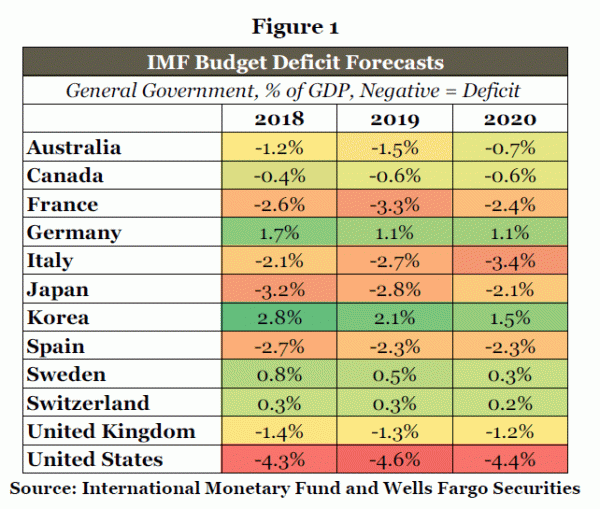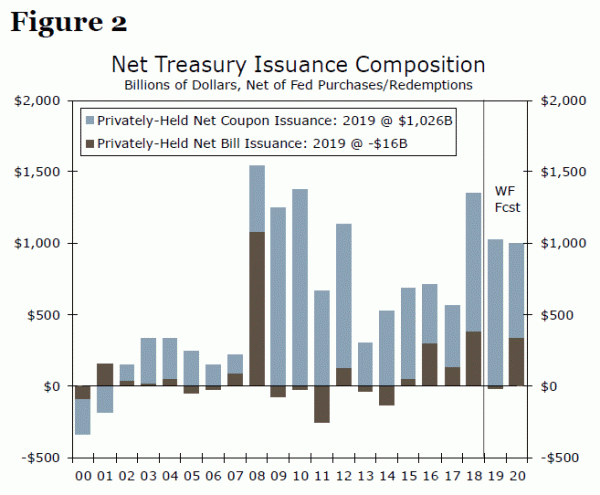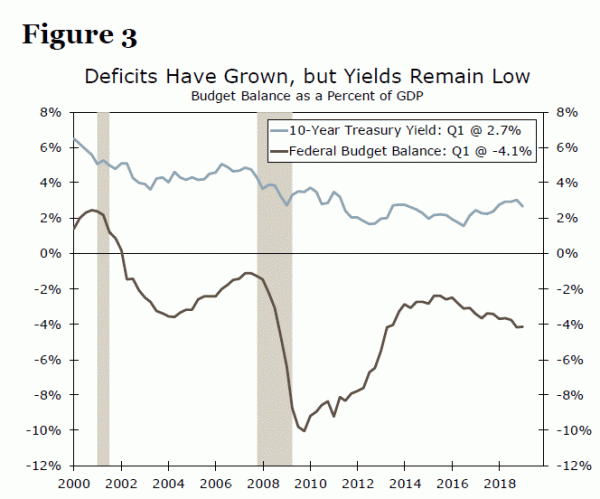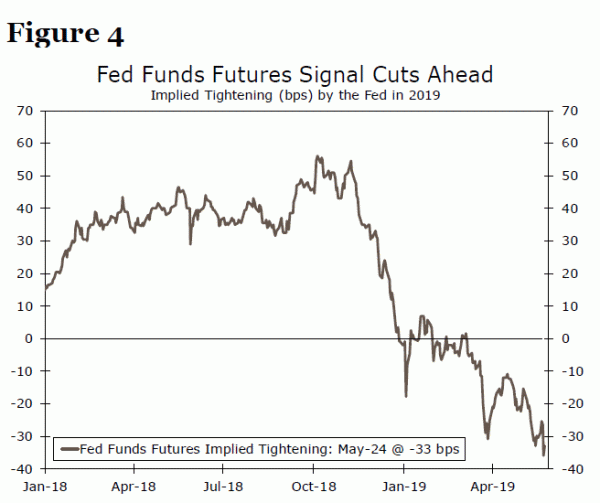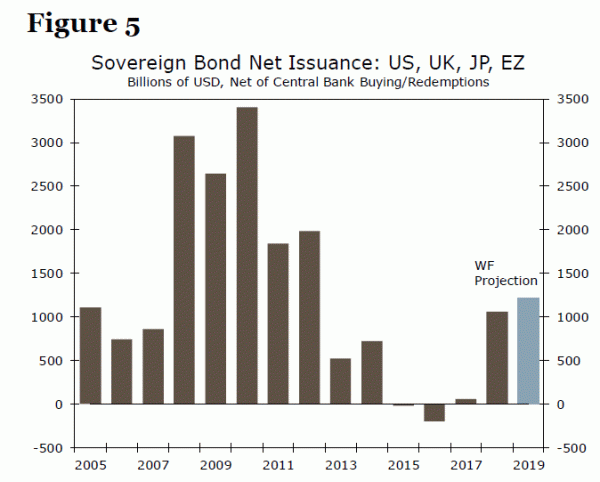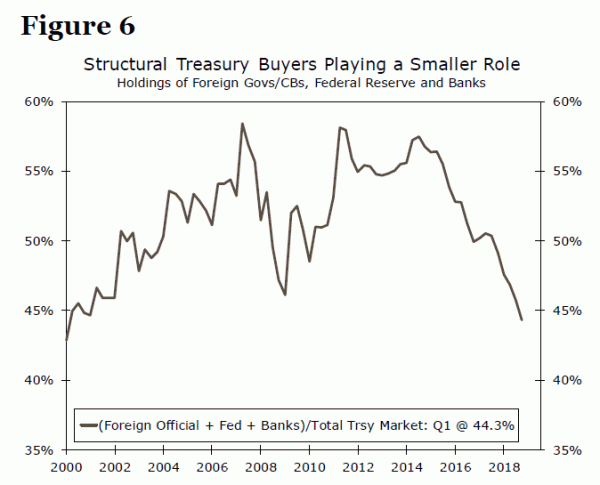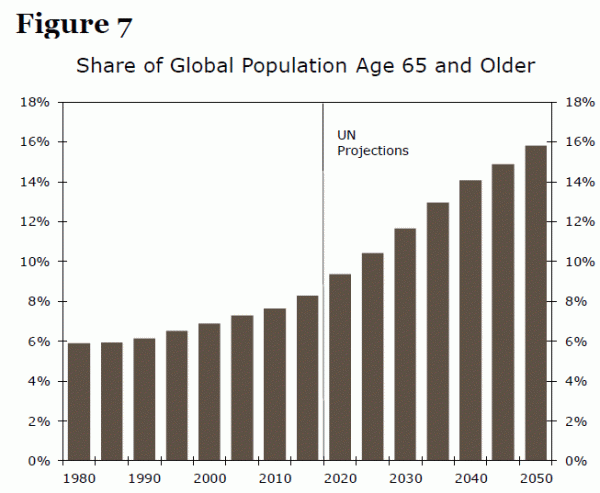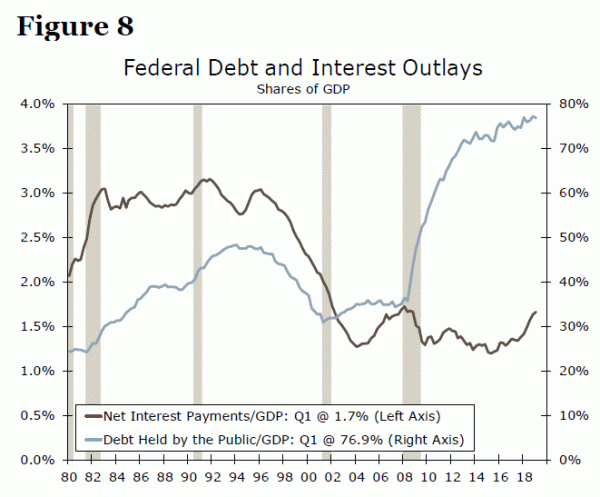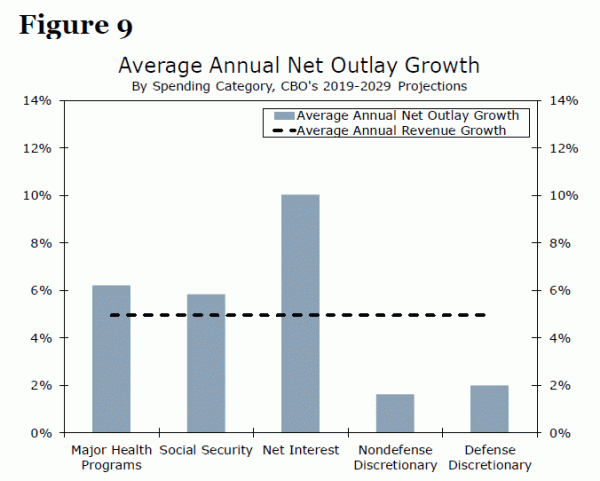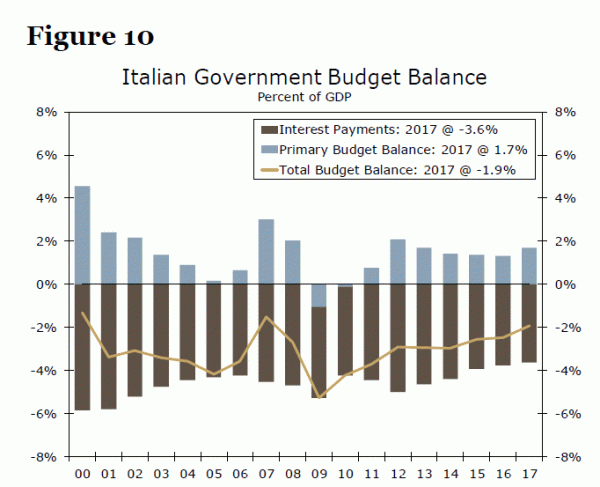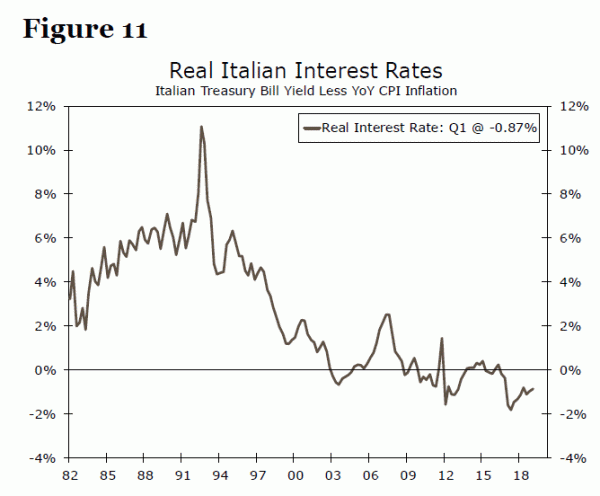Executive Summary
The recent widening in the federal budget deficit and persistently low yields on U.S. Treasury securities have led some observers to question the idea that larger deficits lead to higher interest rates, or even if deficits matter at all. Can the United States really run large budget deficits indefinitely with minimal consequences?
In our view, yields on Treasury securities have remained low in the face of bigger deficits for both cyclical and structural reasons. On the cyclical side, a dovish turn by the Fed and falling growth/inflation expectations have weighed on yields, dominating the upward pressure from more government debt issuance. Net sovereign bond issuance in other major foreign economies has also been quite low recently, due to both fiscal consolidation and to quantitative easing programs by foreign central banks. These factors probably have contributed to downward pressure on U.S. government bond yields as well. Econometric analysis that attempts to control for factors like these suggests that deficits still exert upward pressure on yields, all else equal. On the structural side, the United States enjoys many built-in advantages that make financing large deficits easier. Specifically, the U.S. dollar is the world’s reserve currency, the U.S. economy is the largest in the world and Treasury bills, notes and bonds are the gold standard for liquid, safe assets.
Could some of these circumstances change one day, making it much harder to finance structurally large budget deficits? Of course, though when or whether they will is up for debate. In our view, it is not that deficits no longer matter. Rather, favorable circumstances for large-scale sovereign debt issuance exist today, but that does not mean they will exist forever.
If Deficits Matter, Why Aren’t Yields Higher?
The federal budget deficit steadily narrowed in the years following the Great Recession, eventually hitting a cycle low of 2.4% of GDP in FY 2015. Since then, the deficit has jumped, widening to a projected 4.5% of GDP in FY 2019, which ends on September 30. Using the International Monetary Fund’s measure of the general government budget deficit, the United States is currently running one of the largest consolidated government budget deficits in the developed world (Figure 1). The shortfall between outlays and revenues has led to wider deficits and increased issuance of Treasury securities. Not only has Treasury issuance risen, but the Federal Reserve has been allowing Treasury securities to roll off its balance sheet over the past couple years. As a result, markets had to absorb a whopping $1.4 trillion of net Treasury issuance in calendar year 2018, up significantly from $539 billion in calendar year 2017. Our projection for 2019 net issuance is a bit lower, but we still believe it is likely to be north of $1 trillion (Figure 2).
This robust pace of debt issuance comes at a time when federal debt held by the public as a percent of GDP is the highest it has been since 1950, when debt levels were still falling from their record highs during World War II. The outlook for the decade ahead is for even more red ink, as the Congressional Budget Office (CBO) projects that, under current law, the debt-to-GDP ratio will rise to 92%, up from about 78% today. Critically, these assumptions are based on current law, which includes the eventual expiration of several parts of the Tax Cuts and Jobs Act. If some or all of these tax cuts are extended or made permanent, the end result would likely be even larger deficits and debt.
Yet, despite large issuance volumes in the near term and an ominous medium-to-longer term outlook, interest rates remain stubbornly low by historical standards. The yield on the 10-year U.S. Treasury note is currently around 2.30%, a few basis points below where it traded on the final day of 2017. Back in 2006-2007, when the budget deficit was less than 1-2% of GDP and debt levels were half of their current levels, the 10-year yielded close to 5%, essentially double today’s rate (Figure 3).
Economic theory posits that when the government issues debt, someone, somewhere has to buy it using their pool of available savings. Had the government not issued that debt, that savings would be used to finance something else, regardless of what that something is (corporate bonds, mortgages, equities, etc.). This “crowding out” effect pushes up the cost of capital and interest rates, all else equal. If this is true, then why have longer-term interest rates been relatively flat in the face of so much new government debt? Perhaps the primary reason is that, unlike in an economic model, not all else has been equal.
Back in early November 2018, the 10-year yield had risen quite a bit, to around 3.25%, the highest level since 2011. However, since then, some key drivers of U.S. Treasury yields have changed significantly. Fed funds futures imply that the market swung from pricing in two 25 bps rate hikes by the Fed to pricing in one full cut, a net swing of 75 bps (Figure 4). Inflation expectations, as measured by the difference in yield between 10-year nominal and Treasury Inflation-Protected securities, have fallen about 30 bps over the same period. Many analysts have also scaled back their estimates for 2019 real global GDP growth since last fall. So while the yield on the 10-year Treasury note has retraced most of its move since the end of 2017, weaker growth/inflation expectations and a more dovish Fed could simply be dominating the deficit’s effect on yields.
What other factors might explain this recent lack of a relationship between U.S. deficits and rates? One is that the United States has probably benefitted from ramping up Treasury issuance at a time when many other developed countries have seen a slowdown in net sovereign bond supply, due to both fiscal consolidation and quantitative easing by their central banks. The combined euro area budget deficit narrowed to 0.6% in 2018 from 3.7% in 2012, while Japan’s budget deficit narrowed to 3.2% from 8.6% over the same period. The United Kingdom saw an even sharper fiscal consolidation, as the country’s budget deficit narrowed from 7.5% in 2012 to 1.4% in 2018. At the same time, the European Central Bank, the Bank of Japan and the Bank of England ramped up their purchases of government bonds (as well as other securities) at various points over this period. Combining each country’s budget deficit, netting out respective central bank purchases via quantitative easing programs and putting the total into U.S. dollars, total sovereign bond issuance in the United States, Eurozone, Japan and the United Kingdom was essentially zero from 2014-2016 (Figure 5). Though this story has changed a bit lately, it has been driven almost entirely by developments in U.S. fiscal/monetary policy. If these other countries were also robustly issuing new sovereign debt, the U.S. Treasury might not have been able to sell its bonds at such low yields.
Another critical consideration that is sometimes forgotten is that the deficit/issuance narrative only tells half the story, that of the supply side. If demand is also growing very rapidly, either through higher total savings generally or through a greater preference for U.S. Treasury bills, notes and bonds specifically, then the supply may not be enough to meet demand at the prevailing price. In the previous expansion, Ben Bernanke helped popularize the idea of a “global savings glut”, or the idea that there existed a global excess of desired saving over desired investment.1 This hypothesis was offered to help explain the “Greenspan conundrum” of persistently low longer-term interest rates in the mid-2000s.
The global savings glut hypothesis has many facets, but perhaps the most relevant to this discussion was the significant buildup of foreign exchange reserves, especially in Asia, starting in the late 1990s. The foreign “official” sector, which is largely comprised of foreign central banks and government entities that own FX reserves, saw its holdings of U.S. Treasury securities rise an astounding $3.4 trillion from 2000-2012. To put that number in some context, this means that foreign official buyers absorbed roughly 44% of the total net Treasury issuance over that period. Two other buyers with somewhat price-insensitive preferences have also stepped up their holdings significantly in the current expansion. The Federal Reserve ramped up its holdings of Treasury securities via its quantitative easing programs, and banks with a presence in the United States increased their holdings largely in response to new financial sector regulations.
More recently, however, these players have faded in importance. Foreign official holdings of Treasury bills, notes and bonds have been more or less flat since 2012, and bank holdings have grown more slowly recently after a ramp up from 2013-2016. The Fed stopped buying Treasury securities at the end of 2014, and it has been reducing its holdings since October 2017. As a result, the combined holdings of Treasury securities by foreign official institutions, the Fed and banks have fallen as a share of the total Treasury market to levels not seen in nearly 20 years (Figure 6). Thus far, private domestic investors have stepped in and absorbed most of the new supply, though not without disruptions, particularly in repo markets.2
The Federal Reserve will likely digest some of this supply in the year ahead as it replaces maturing mortgage-backed securities and allows its balance sheet to slowly grow organically over time. However, with deficits of $1 trillion or more expected for the foreseeable future, market participants will still need to buy the lion’s share of this massive issuance even if the Federal Reserve buys a couple hundred billion dollars’ of Treasury securities per year in the decade ahead. With the share of the population over 65 on pace to rise dramatically in the years ahead (Figure 7), the global savings rate may not go much higher. The preference of an aging’s population for fixed income securities over equity securities could be one plausible avenue through which demand for U.S. Treasury bills, notes and bonds will keep pace with supply. Indeed, American households have been the single largest buyer of Treasury securities over the past 18 months, helping to fill the void left by foreign central banks, the Federal Reserve and others. Still, it remains to be seen whether American households can finance such large and growing budget deficits indefinitely. Just because households have developed an appetite for Treasury securities over the past 18 months does not mean this investment preference will last forever.
As one last point, investment decisions are not made in a vacuum. Although the United States may have some economic and fiscal challenges, it is not the only country that does. Japan, France, Italy and several other developed market economies have public debt challenges just like the United States. And while rapidly modernizing countries like China and India could one day take the economic mantle from the United States, the reforms and economic/financial market maturation that are still needed in those countries remain significant. Germany is a relatively large economy with fairly sound fiscal policy, and one could point to its sovereign bond market as a plausible alternative. But, the market for German bunds is a bit less than $1.5 trillion, much smaller than the $16 trillion market for Treasury securities. The U.S. Treasury market is the deepest, most liquid bond market in the world, backed by the world’s reserve currency and the largest and most diversified economy in the world. While these U.S. advantages seem unlikely to change anytime soon, it would be much more challenging for the United States to run large budget deficits indefinitely and with minimal economic consequences were another country (or countries) to wrest these advantages away.
The economics literature is full of attempts to use econometrics to try to control for many of the factors discussed above, and recent developments have led some researchers to re-examine the relationship between deficits and U.S. interest rates.3,4,5 Estimates vary depending on how each respective study treats the structural form of the variables (for example, deficits versus debt, or realized versus expected deficits), but generally speaking the association between larger budget deficits and higher interest rates appears to stand when controlling for these other factors. A very general rule of thumb that emerges from the literature is that a one percentage point increase in the deficit is associated with an increase in longer-term yields on Treasury securities of roughly 15-25 bps. If this general rule of thumb is correct, it makes some sense why the deficit effect may have been dominated by everything else going on around the world in recent years.
For those still skeptical, consider a more simple way to think about the issue: would yields be lower today if Treasury issuance had not exploded in 2018-2019? It is a counterfactual that is impossible to know for sure, but we suspect that the answer is yes, at least qualitatively.
If Interest Rates Remain Low, Does More Borrowing Really Matter?
Another argument against large, sustained budget deficits is that an ever-rising debt burden can lead to debt servicing costs crowding out other segments of a government’s budget. As interest costs rise, this leaves less money for other budgetary needs, such as national defense, education, infrastructure or health care. However, even though the federal government’s debt-to-GDP ratio has risen substantially, federal net interest spending as a percent of GDP is historically low, though it has risen a bit in the past few years (Figure 8). With few signs of interest rates rising substantially anytime soon, does more debt really matter if it can be easily and affordably financed?
Major entitlement programs like Social Security, Medicare and Medicaid are among the biggest drivers of spending growth over the longer-run. These programs are some of largest segments of the federal budget, and spending on Social Security and the major healthcare programs is projected to grow faster than revenues over the next decade. However, it is actually interest spending that is projected to grow the fastest in the coming years (Figure 9). This is in part because of the growing stock of debt over time, but much of this budgetary pressure from net interest spending can be attributed to the assumptions made by CBO about interest rates. CBO assumes that, over the long term, the yield on the 10-year Treasury security will reach a steady state of 3.7%, with short-term interest rates a bit above 3%. Given the structural downshift in yields that has occurred during this expansion, CBO has been revising this forecast down for years. As recently as 2015, its steady state 10-year Treasury yield forecast was 4.6%.
What if interest rates over the next decade are much closer to where they are today? In a sensitivity analysis, we look at what the federal-debt-to-GDP ratio would be if the yield on the 10-year Treasury note averaged 2.8% over the next decade. Why 2.8%? We arrive at 2.8% as the sum of 2% inflation (the Fed’s inflation target) and the Laubach-Williams estimate of the real rate of interest, a commonly cited metric of so-called “r-star.”6 This assumed 2.8% rate is also relatively close to the 2.5% rate that the yield on the 10-year Treasury security has averaged over the past decade.
Under CBO’s baseline assumptions, the debt-to-GDP ratio is projected to rise about 16 percentage points over the next decade. Using this alternative assumption about lower interest rates, the projected rise in the debt-to-GDP ratio is about 9 ppts. As a reminder, this includes the assumed expiration of many parts of the Tax Cuts and Jobs Act in the coming years. So, even if interest rates hold steady at these levels, the debt-to-GDP ratio would still likely increase over the next decade, as would interest costs. But what if rates went even lower, possibly even negative as they are in parts of Europe and Japan?
This is of course a possibility, but it is also possible that interest rates rise could rise meaningfully at some point in the future. Inflation could spike, or global productivity growth could rebound, creating new investment opportunities around the world and pushing up real interest rates. Demand for fixed income securities could wane as global saving rates level off or even decline, or major economies could ramp up sovereign bond supply at once. Regardless of the cause, fiscal policymakers could find themselves in a challenging spot if interest rates were to rise substantially in an environment of high deficits/debt levels. The government would be trying to roll over a very large and growing stock of debt at higher rates, creating even more debt and squeezing hard on revenue resources and potentially exerting a drag on private capital formation. Consider Italy, a country notable for having one of the largest public debt burdens in the developed world. Italy has been more or less running a primary budget surplus for years (Figure 10).7 In a sense, Italy’s public finances are still grappling with the accumulation of debt during a period of very high real interest rates in the 1980s and 1990s (Figure 11).
Pulling It Together: What Does This All Mean?
The recent surge in U.S. Treasury issuance and persistently low yields on Treasury securities have raised questions about the standard economic relationship assumed to exist between these two variables. After reconsidering this relationship, we believe there are a few key takeaways. First, budget deficits do not influence interest rates in isolation. Upward pressure on interest rates from budget deficits can, for periods of time, be dwarfed by other factors, such as changing growth/inflation dynamics, dovish monetary policy, robust demand for the asset class and light issuance volumes from other countries. Second, the United States is endowed with some advantages, such as the dollar’s status as the world’s reserve currency, that probably allow it to run larger budget deficits than would otherwise be the case. Third, perpetually low interest rates are probably not enough to solve all of the United States’ fiscal challenges. If interest rates were to hold at roughly today’s levels, the federal government’s debt-to-GDP ratio would likely keep rising. Finally, if interest rates ever did jump meaningfully, policymakers would need to roll over a very large and growing stock of debt at higher rates, creating even more debt, squeezing even harder on revenue resources and potentially exerting a drag on private capital formation. In our view, it is not that deficits no longer matter, but rather that just because favorable circumstances for large-scale debt issuance exist today does not mean that one can assume they will exist forever.
1 Bernanke, B. (2005). “The Global Saving Glut and the U.S. Current Account Deficit.” Remarks by Governor Ben S. Bernanke at the Sandridge Lecture, Virginia Association of Economists, Richmond, Virginia.
2 For more on the connection between Treasury supply and disruptions in the repo market, see our November 29, 2018 report “Getting Technical: Managing the Fed Funds Rate“.
3 For example, see Gamber, E. and Seliski, J. (2019). “The Effect of Government Debt on Interest Rates.” Working Paper 2019-01, Congressional Budget Office.
4 Warnock, F.E. and Warnock, V.C. (2009). “International Capital Flows and U.S. Interest Rates.” Journal of International Money and Finance 28, 903-919. For a more recent update to the Warnock & Warnock framework, see this blog post
5 Laubach, T. (2009). “New Evidence on the Interest Rate Effects of Budget Deficits and Debt.” Journal of the European Economic Association, Volume 7, Issue 4, 858-885.




